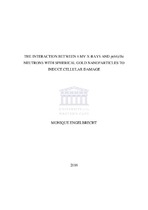| dc.description.abstract | Despite the advances in therapies such as chemotherapy and radiotherapy, tumours have been shown to be resistant to the treatments. Gold nanoparticles (AuNPs) have been recognized as effective radiosensitizers of low energy (e.g. 200–500 kV) X-rays, leading to the emission of
Auger electrons that cause highly localised ionizing damage to cells. Spherical AuNPs were synthesised via the reduction of the chloroaurate ions by sodium citrate. Characterisation of AuNPs involved UV-visible spectrophotometry, zeta (Z) potential, dynamic light scattering (DLS) and polydispersity index (PDI) measurements for determination of surface plasmon resonance (SPR), surface charge and stability, as well as
transmission electron microscopy (TEM) for hydrodynamic core sizes, size distribution width and shape of AuNPs. Both the 5 and 10 nm AuNPs were found to be anionic with λmax absorbance of 525 nm and uniform size distribution. DLS measurement at 38.12 nm and 48.50 nm, respectively for 5 nm and 10 nm AuNPs, points to aggregation of the AuNPs. However, TEM measurements confirmed the core size of the 10 nm AuNPs. Non-malignant Chinese hamster ovary (CHO-K1), brain endothelial (BEnd5), breast (MCF-10A), isolated human lymphocytes and malignant breast (MCF-7) cell lines were treated with 50 μg/ml of AuNPs, and irradiated with either 1, 2 or 4 Gy X-rays or 1 or 2 Gy p(66)/Be neutron radiation. The γ-H2AX foci assay, cytokinesis-block micronucleus assay, MTT assay and fluorescence-activated cell sorting (FACS) was used to determine that amount of double stranded breaks (DSBs) in isolated lymphocytes, the presence and number of micronuclei (MNi) within binucleated cells (BNCs), cell viability and cell cycle progression, respectively. Preliminary experiments that established the reliability of the study regarding the induction of DNA damage after the bombardment of AuNPs by scattered low kV X-rays, were carried out on lymphocytes. Combined treatment (AuNPs and radiation) resulted in more endogenous foci in comparison to lymphocytes that were treated with AuNPs only. The CHO-K1 and MCF-7 cells showed higher MNi frequencies after the combination treatment of AuNPs and radiation compared to the number of MNi in samples exposed to AuNPs and radiation separately. The AuNPs alone influenced the cellular kinetics of all cell types. Interaction indices, which is the enhancement factor of AuNPs in combination with radiation, for AuNPs and 6 MV 2 Gy X-rays of 1.6 to 1.7 and 1.3 to 1.4 have respectively been determined for CHO-K1 and MCF-7 cells, whilst that for the other cell types used in the study were not different from Unity. As expected, the interaction indices between AuNPs and p(66)/Be neutrons was lower than the interaction indices after 2 Gy X-rays, as p(66)/Be neutrons interact only with the nuclei of the AuNP's atoms and the X-ray photons interact with the
orbital electrons of the atoms of the AuNPs leading to Auger electron emission. The cell viability assay showed that 50 μg/ml of AuNPs had an inhibitory effect on cellular proliferation, in all four cell linnes whereas the lower concentrations (2.5, 5 and 10 μg/ml) had no effect. Results in this study, revealed an increase in the accumulation of CHO-K1 an MCF-7 cells in the G₂/M phase of the cell cycle after being treated with AuNPs followed by X-ray radiation, suggesting that the cells have possibly been sensitised to the damaging effects of radiation. Further studies are required to quantify internalised AuNPs and to then link the possible concentration differences of the AuNPs to differences in radiation damage effects observed for the different cell types. | en_US |

